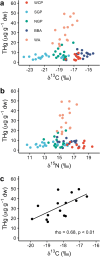Mercury Concentrations in Feathers of Albatrosses and Large Petrels at South Georgia: Contemporary Patterns and Comparisons with Past Decades
- PMID: 38762667
- PMCID: PMC11142957
- DOI: 10.1007/s00244-024-01067-9
Mercury Concentrations in Feathers of Albatrosses and Large Petrels at South Georgia: Contemporary Patterns and Comparisons with Past Decades
Abstract
Mercury (Hg) is an environmental contaminant that can negatively impact the health of humans and wildlife. Albatrosses and large petrels show some of the highest levels of Hg contamination among birds, with potential repercussions for reproduction and survival. Here, body feather total Hg (THg) concentrations were determined in breeding adults of five species of albatrosses and large petrels in the foraging guild at South Georgia during the mid-2010s. We tested the effects of species, sex and trophic ecology (inferred from stable isotopes) on THg concentrations and compared our results with published values from past decades. Feather THg concentrations differed significantly among species (range: 1.9-49.6 µg g-1 dw), and were highest in wandering albatrosses Diomedea exulans, intermediate in black-browed albatrosses Thalassarche melanophris and northern giant petrels Macronectes halli, and lowest in southern giant petrels M. giganteus and white-chinned petrels Procellaria aequinoctialis. Females were more contaminated than males in all species, potentially due to differences in distributions and diet composition. Across species, THg concentrations were not correlated with feather δ13C or δ15N values, implying that species effects (e.g., breeding and moulting frequencies) may be more important than trophic effects in explaining feather THg concentrations in this foraging guild. Within species, the only significant correlation was between THg and δ13C in wandering albatrosses, which could reflect higher Hg exposure in subtropical waters. Comparisons with THg concentrations from past studies, which reflect contamination from 10 to > 60 years ago, revealed considerable annual variation and some evidence for increases over time for wandering and black-browed albatrosses since before 1950 and from the late 1980s, respectively.
© 2024. The Author(s).
Conflict of interest statement
The authors declare no competing interests.
Figures




Similar articles
-
Mercury exposure in an endangered seabird: long-term changes and relationships with trophic ecology and breeding success.Proc Biol Sci. 2020 Dec 23;287(1941):20202683. doi: 10.1098/rspb.2020.2683. Epub 2020 Dec 23. Proc Biol Sci. 2020. PMID: 33352077 Free PMC article.
-
Accumulate or eliminate? Seasonal mercury dynamics in albatrosses, the most contaminated family of birds.Environ Pollut. 2018 Oct;241:124-135. doi: 10.1016/j.envpol.2018.05.048. Epub 2018 May 24. Environ Pollut. 2018. PMID: 29803026
-
Annual trends in mercury contamination are associated with changing trophic niches of giant petrels.Environ Res. 2025 Apr 1;270:121010. doi: 10.1016/j.envres.2025.121010. Epub 2025 Jan 31. Environ Res. 2025. PMID: 39894149
-
Feather mercury concentrations in Southern Ocean seabirds: Variation by species, site and time.Environ Pollut. 2016 Sep;216:253-263. doi: 10.1016/j.envpol.2016.05.061. Epub 2016 Jun 4. Environ Pollut. 2016. PMID: 27267741
-
Metal and selenium concentrations in blood and feathers of petrels of the genus Procellaria.Environ Toxicol Chem. 2013 Jul;32(7):1641-8. doi: 10.1002/etc.2204. Epub 2013 May 23. Environ Toxicol Chem. 2013. PMID: 23440884
References
-
- Anderson ORJ, Phillips RA, McDonald RA, Shore RF, McGill RAR, Bearhop S. Influence of trophic position and foraging range on mercury levels within a seabird community. Mar Ecol Prog Ser. 2009;375:277–288. doi: 10.3354/meps07784. - DOI
-
- Appelquist H, Asbirk S, Drabæk I. Mercury monitoring: mercury stability in bird feathers. Mar Pollut Bull. 1984;15:22–24. doi: 10.1016/0025-326X(84)90419-3. - DOI
-
- Arcos JM, Ruiz X, Bearhop S, Furness RW. Mercury levels in seabirds and their fish prey at the Ebro Delta (NW Mediterranean): the role of trawler discards as a source of contamination. Mar Ecol Prog Ser. 2002;232:281–290. doi: 10.3354/meps232281. - DOI
-
- Barrett RT, Camphuysen K, Anker-Nilssen T, Chardine JW, Furness RW, Garthe S, Hüppop O, Leopold MF, Montevecchi WA, Veit RR. Diet studies of seabirds: a review and recommendations. ICES J Mar Sci. 2007;64:1675–1691. doi: 10.1093/icesjms/fsm152. - DOI
MeSH terms
Substances
LinkOut - more resources
Full Text Sources
Medical
Miscellaneous

